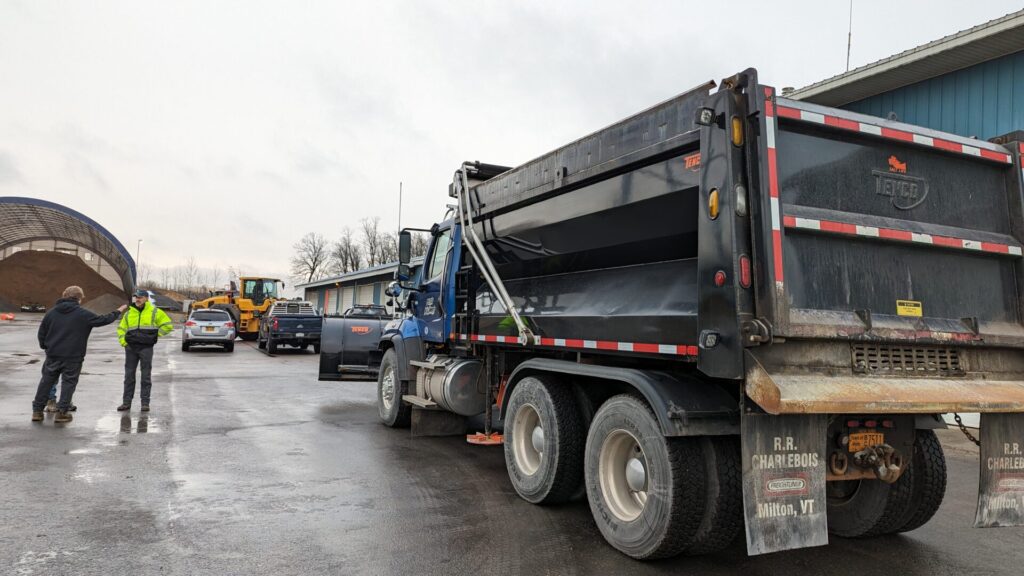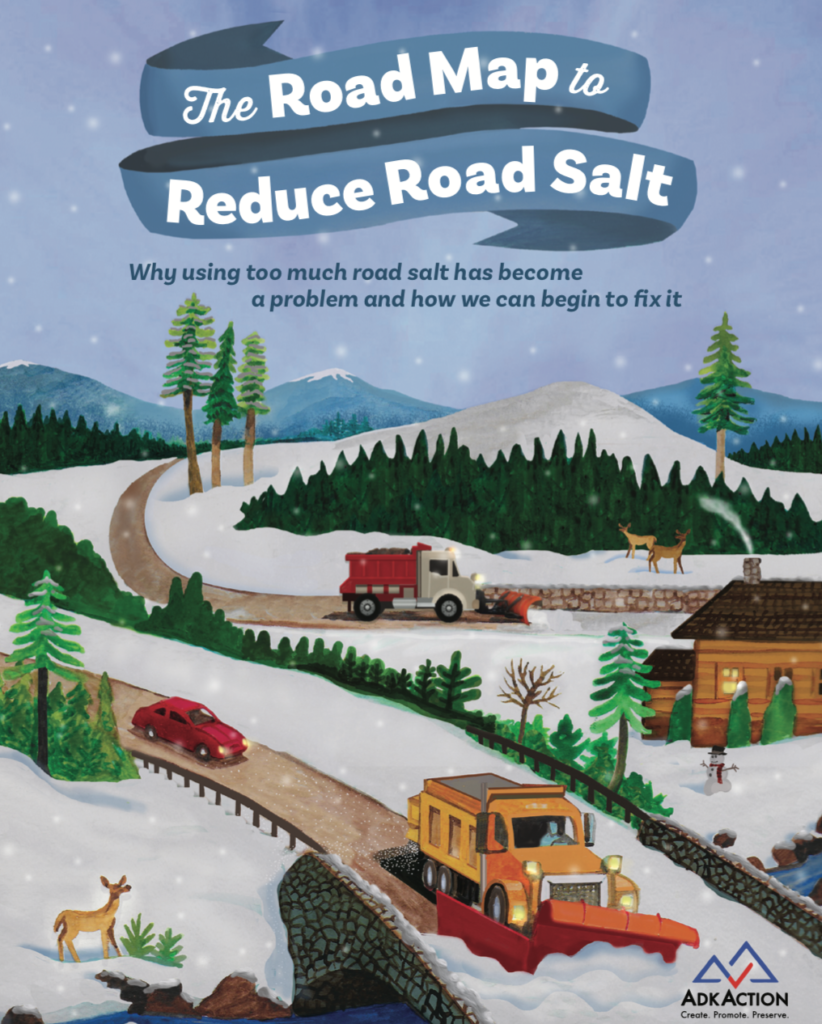
Road Salt Q & A
Guest Author Mikala L’Hote, Graduate Research Assistant with the Adirondack Watershed Institute, shares answers to some of the commonly asked questions about road salt: What is road salt? Also known
Road salt pollution is threatening Adirondack waters and causing premature rust and depreciation of vehicles and infrastructure. Studies indicate that Adirondack drinking water is becoming contaminated at an alarming rate. We are working with a broad group of stakeholders to address this complex issue.
AdkAction’s ‘Clean Water Safe Roads’ public outreach campaign encourages responsible salt application practices for households, businesses, and municipalities in the Adirondack region. All are welcome to get involved in the effort to protect our water from road salt pollution. Get started at AdkAction.org/salt.
Each year, over 190,000 tons of road salt are applied to roadways in the Adirondacks, with New York State using about 2.5 times more salt per lane-mile than county and municipal road crews. As a result of this disparity, studies show that while the state maintains only about a quarter of the roads in the Park, salt runoff from state roads is responsible for the vast majority of water contamination.
AdkAction has been studying, educating, and advocating for a reduction in road salt since 2010. We coordinated the Adirondack Road Salt Working Group to foster a unified regional strategy to reduce road salt pollution and to publicly recommend and support alternative de-icing products, techniques, and best management practices. Together with our partners, we have co-hosted five Road Salt Conferences and Summits and successfully advocated for the creation of six road salt pilot areas in the Adirondacks with NYS DOT.
In 2019, AdkAction helped sponsor a study by the Paul Smith’s College Adirondack Watershed Institute to test 500 Adirondack wells and found that 64% had sodium levels exceeding the federally recommended limit. When a private well is contaminated by salt, it becomes a hazard for people with high blood pressure and other health conditions. The situation can create a costly crisis for local families who need to buy bottled water and replace appliances, pipes, and even drill new wells.
In collaboration with other advocacy organizations, AdkAction lobbied for the New York State Randy Preston Road Salt Reduction Act which was signed into law by Governor Cuomo on December 3rd, 2020. The Adirondack Road Salt Reduction Task Force, established by this Act in late 2021, was charged to assess
the impacts of road salt on the environment and to conduct a comprehensive review of best management practices for the use of road salt within the Adirondack Park while also considering public safety. Former AdkAction Executive Director, Brittany Christenson, was appointed to the Task Force, along with representatives from several State agencies, communities and organizations.
In 2022, AdkAction initiated the Clean Water, Safe Roads Partnership, which engages municipalities in reducing road salt usage. Thanks to funding from the Lake Champlain Basin Program and the New England Interstate Water Pollution Control Commission, this initiative is part of our ongoing efforts to protect the environment.
Currently, our Clean Water Safe Roads Network comprises municipalities like Washington County, Plattsburgh, Chesterfield, AuSable, Peru, Saranac, and Hague. AdkAction has been working closely with these partners, conducting surveys of their winter road maintenance practices and providing workshops to address strategies for sustainable winter road maintenance. We’re excited to engage new communities in our efforts–together, we aim to make a positive impact on the environment, water quality, and community safety.
In October 2023, AdkAction launched a new public outreach and awareness campaign, ‘Clean Water Safe Roads,’ in partnership with the Ausable River Association. This campaign is designed to address the pressing issue of road salt pollution in the Adirondack region and educate both residents and visitors to our region about the far-reaching impact of road salt contamination on our water bodies, aquatic life, infrastructure, and drinking water.
After nearly half a century of increasing levels of road salt application, our region is now experiencing negative impacts resulting from over salting. The slideshow below highlights some of the relevant local research that has been conducted to help society better understand the consequences of over-salting roadways. You can read all of the research summaries in the Road Map to Reduce Road Salt booklet here.
A review of the combined threats of road salts and heavy metals to freshwater systems
Schuler, M. S. and Relyea, R. A. (2018). A review of the combined threats of road salts and heavy metals to freshwater systems. Bioscience. In Press
Regional Salinization of Adirondacks Lakes by Road Salt
Kelting, D.L., C.L. Laxson, & E.C. Yerger (2012). Regional analysis of the effect of paved roads on sodium and chloride in lakes. Water Research, 46:2749-2758.
Road runoff impacts lakes and streams throughout the Adirondacks
Regalado, S.A., & D.L. Kelting (2015). Landscape level estimate of lands and waters impacted by road runoff in the Adirondack Park of New York State. Environmental Monitoring & Assessment, 187:510-525.
Road salt interrupts turnover of Mirror Lake
Wiltse, B., Yerger, E.C., Pionteck, N.C., & Laxson, C.L. 2018. Mirror Lake 2017 Water Quality Report. Ausable River Association, Wilmington.
Road salt contamination alters the sex ratios of wood frogs
Lambert, M. R., Stoler, A. B., Smylie, M. S., Relyea, R. A., Skelly, D. K. (2017). Interactive effect of road salt and leaf litter on wood frog sex ratios and metamorphic sexual size dimorphism. Canadian Journal of Fisheries and Wildlife Science 74:141-146,
DOI:10.1139/cjfas-2016-0324
Road salt triggers a trophic cascade
Hintz, W. D., B. M. Mattes, M. S. Schuler, D. K. Jones, A. B. Stoler, L. Lind, and R. A. Relyea. 2017. Salinization triggers a trophic cascade in experimental freshwater communities with varying food-chain length. Ecological Applications 27: 833-844. DOI: doi/10.1002/eap.1487/
Road salts and natural stressors in freshwater wetland communities
Jones, D.K., B.M. Mattes, W.D. Hintz, M.S. Schuler, A.B. Stoler, L.A. Lind, R.O. Cooper, R.A. Relyea. 2017. Investigation of road salts and biotic stressors on freshwater wetland communities. Environmental Pollution 221:159-167. https://doi.org/10.1016/j.envpol.2016.11.060
Road salts negatively affect rainbow trout
Hintz, W.D. and R. A. Relyea. 2017. Impacts of road deicing salts on the early-life growth and development of a stream salmonid: Salt type matters. Environmental Pollution 223:409-415 DOI: 10.1016/j.envpol.2017.01.040

Looking for straightforward research summaries detailing the impacts of road salt pollution? Want a simple list of best practices? Look no further. Download the Road Map to Reduce Road Salt here or request a hardcopy by emailing [email protected].
Acknowledgments
This booklet is a part of AdkAction’s Road Salt Reduction Project with funding provided by the Environmental Protection Fund as administered by the New York State Department of Environmental Conservation. Any opinions, findings, and/or interpretations of data contained herein are the responsibility of the author(s) and do not necessarily represent the opinions, interpretations or policy of Rochester Institute of Technology and its NYS Pollution Prevention Institute or the State.
The following best practices were originally compiled in, Review of Effects and Costs of Road De-icing with Recommendations for Winter Road Management in the Adirondack Park, a comprehensive report underwritten and distributed by AdkAction. Prepared by Daniel L. Kelting, Executive Director, and Corey L. Laxson, Research Associate, at Paul Smith’s College Adirondack Watershed Institute.
Map the road network: The New York State Department of Environmental Conservation (NYSDEC), working together with the Adirondack Park Agency (APA) and the Department of Transportation (NYSDOT) should utilize existing knowledge on the potentially harmful effects of road salt together with geospatial data to develop a map of sensitive areas. The state should then promulgate use of this map to tailor application rates, methods, and deicer types to minimize the environmental impacts of de-icing. Areas deemed too sensitive for any de-icing alternative should be marked with road signs to warn drivers of potentially icy conditions (like the warning signs already posted on many bridges).
Invest in RWIS: The State of New York should invest in a networked Road Weather Information System (RWIS). Being installed throughout the country now, these weather stations provide real time information on road and weather conditions. RWIS data allows the timing, the rate, and the type of de-icing chemical application to be tailored, which reduces application costs and increases deicer effectiveness. These systems can pay for themselves in one winter with the savings realized through decreased application costs.
Implement precision application: Precision application refers to the utilization of new technologies that ensure the de-icing or anti-icing chemicals are applied in the appropriate method and at the appropriate rate. Application rates are optimized through anti-icing practices, automatic vehicle location (AVL), vehicle-based sensor technologies, RWIS, and Management Decision Support Systems (MDSS).
Employ anti-icing: Anti-icing is the proactive use of any deicer with the intent of preventing snow and ice from bonding to the road surface. The advantages of anti-icing are that it: (1) maintains the roads at the best condition possible during winter storms, (2) uses fewer chemicals, therefore it is cost efficient and better for the environment, and (3) it makes subsequent road clearing easier. Anti-icing can decrease costs by greater than 50% compared to conventional de-icing (p57).
Use targeted application techniques: Conventional rotary spreaders throw a significant amount of deicer outside of the planned treated area (over 30 percent deicer waste has been reported); this wastes the deicer, reduces the effectiveness of the treatment and increases potential for off site impacts. More targeted methods reduce the amount of deicer needed and increase deicer effectiveness. Less deicer should be applied when rising temperature is forecasted while more deicer should be applied when decreasing temperature is forecasted.
Windrowing: Apply deicer in a concentrated 4 to 8ft wide strip down the centerline of lesser traveled roads, rather than to the entire surface. The snow melts faster and the exposed pavement warms and melts the adjacent untreated pavement.
Zero-velocity spreaders: “Place” deicer on the road surface with little impact which minimizes bouncing and waste. By reducing the amount of waste, these spreaders can reduce materials cost by as much as 50 percent (p61).
Pre-wetting: The deicer becomes a melting agent when moisture is added, so pre-wetting can result in faster melting. Apply as brine using a spray delivery system, which also keeps the deicer on the surface being treated.
Use alternative deicers: In areas designated as too sensitive for road salt but also with high risk safety concern, use alternative deicers with fewer negative impacts. Trucks can have multiple bins and can switch de-icing types on the fly based on a map, or road signage that indicates the correct deicer to apply at a given location. Alternative deicers may also be warranted based on temperature. Road salt is most effective above 20°F, calcium chloride is effective down to 0°F, and magnesium chloride is effective down to -13°F. Thus, if sub 20°F temperatures are forecasted, deicers with lower effective temperatures should be used; else the road salt is wasted.
Upgrade equipment: Well maintained and calibrated automatic spreader systems have been shown to reduce unnecessary road salt application by over 40 percent (p61). Live-edge and double edge plows are more effective at removing snow and ice from road surfaces.
Improve training: A more sophisticated road de-icing plan requires greater operator training. Operators should be educated on the consequences of overuse of road salt, so they are aware of all the costs. Training modules for alternative deicers, application techniques, use of RWIS data, etc., are available from several sources. Training and annual follow-up continuing education should be mandated. Training modules need to be up-to-date.
Provide public education: The driving public should be informed about any new deicing practices and policies. The public has a vested interest in safe roads and a clean environment. Plus, public expectations dictate the level of service that must be provided, so an informed public can have more realistic expectations for driving during the winter months.
Implement, monitor, and evaluate: A comprehensive system should be put in place that facilitates implementation, tracks success and concerns, and allows for adaptive management. The NYS DOT should establish test areas along state routes in small watersheds to apply alternatives and monitor effectiveness and environmental and infrastructure impacts.

Liability is perceived as one of the top barriers to road salt reduction, cited by private applicators, municipal crews, and state DOT’s. Our research has shown that written snow and ice plans provide significant legal protection for salt applicators. See the resources below for more specific information.
1. Liability video presentation by James Gelormini, former NYS Assistant District Attorney from our 2014 Road Salt Conference: Watch here.
2. The Mirror Lake Association solicited a legal opinion concerning the protection of Municipalities from being sued while working to reduce road salt applications. The opinion states that Municipalities are protected by state legislation in that a written complaint has to be filed concerning negligence of a sidewalk or street before an incident is reported. Read the full legal opinion here.
3. Benefits of a Written Snow and Ice Control Plan by Duane E. Amsler Sr. P.E.
4. Model Plan for Snow and Ice Control, Town of Bolton, NY, Lake George Watershed, 2017.
5. City of West Des Moines Snow and Ice Control Manual.
Municipalities across the Adirondacks are signing on to our Pledge to Reduce Road Salt MOU to show their support for our vision of a Park-wide salt reduction strategy.
Act locally: Ask your municipality to sign AdkAction’s Pledge to Reduce Road Salt. This memorandum of understanding identifies issues associated with road salt applications, as well as steps that may be taken to help reduce related impacts.
To date, the 27 Adirondack towns and villages listed below have signed the Pledge, and are working toward a proactive approach to reducing their road salt usage while maintaining safe driving conditions through the use of best practices. Download the Pledge to Reduce Road Salt Municipal MOU here and urge your local officials to pass a resolution in favor of signing the Pledge. Signed Pledges should be filed by sending to [email protected]
Special thanks to the following municipalities who have shown their commitment to sustainable winter road maintenance:
Ausable
Bolton
Brighton
Chester
Chesterfield
Colton
Dresden
Duane
Forestport
Hague
Harrietstown
Horicon
Johnstown
Keene
Lake George
North Elba
North Hudson
Parishville
Piercefield
Putnam
Queensbury
Stratford
Ticonderoga
Village of Lake George
Webb
Willsboro
Wilmington

Guest Author Mikala L’Hote, Graduate Research Assistant with the Adirondack Watershed Institute, shares answers to some of the commonly asked questions about road salt: What is road salt? Also known

On January 24, AdkAction Executive Director Sawyer Bailey testified at the NY State Legislature Joint Budget Hearing on Transportation. She shared some of the negative impacts overuse of road salt

Winter salt pollution is often discussed as a predominantly ecological issue, but salty drinking water has real impacts on human health. The unequal consequences of those impacts have environmental justice

